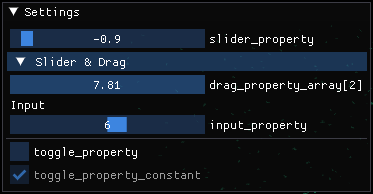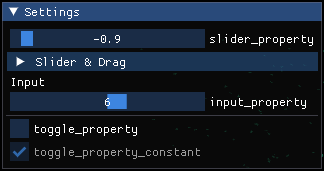Visualising Additional Details
In addition to visualising agents, you may wish to visualise the environment bounding box, or environment properties.
User Interface (Environment Properties)
FLAME GPU visualisations can be extended by adding one or more user-interface panels using newUIPanel(). This returns a PanelVis which can be used to customise a user-interface allowing users to see and interactively update environment properties during a simulation’s execution.
Environment properties marked as constant within the model, cannot be updated via UIs and will instead appear disabled.
// Configure the visualisation
flamegpu::visualiser::ModelVis m_vis = cudaSimulation.getVisualisation();
// Create a new UI panel named "Settings
flamegpu::visualiser::PanelVis ui = m_vis.newUIPanel("Settings");
// Create a named collapsible section "Sliders"
ui.newSection("Slider & Drag");
// Add an environment property slider with the inclusive range [-1.0, 1.0]
ui.newEnvironmentPropertySlider<float>("slider_property", -1.0f, 1.0f);
# Add an environment property array element drag_property_array[2] drag with the inclusive range [0.0, 10.0]
ui.newEnvironmentPropertyDrag<float>("drag_property_array", 2, 0.0, 10.0, 0.1);
// End the collapsible section
ui.newEndSection();
// Add a static text label
ui.newStaticLabel("Input");
// Add an environment property input with step speeds 1 & 10
ui.newEnvironmentPropertySlider<int>("input_property", 1, 10);
// Add a horizontal separator
ui.newSeparator();
// Add an environment property checkbox
ui.newEnvironmentPropertyToggle<int>("toggle_property");
// Add an environment property checkbox, for a constant property
ui.newEnvironmentPropertyToggle<int>("toggle_property_constant");
# Configure the visualisation
m_vis = cudaSimulation.getVisualisation();
# Create a new UI panel named "Settings
ui = m_vis.newUIPanel("Settings")
# Create a named collapsible section "Sliders"
ui.newSection("Slider & Drag")
# Add an environment property slider with the inclusive range [-1.0, 1.0]
ui.newEnvironmentPropertySliderFloat("slider_property", -1.0, 1.0)
# Add an environment property array element drag_property_array[2] drag with the inclusive range [0.0, 10.0]
ui.newEnvironmentPropertyDragFloat("drag_property_array", 2, 0.0, 10.0, 0.1)
# End the collapsible section
ui.newEndSection();
# Add a static text label
ui.newStaticLabel("Input")
# Add an environment property input with step speeds 1 & 10
ui.newEnvironmentPropertySliderInt("input_property", 1, 10)
# Add a horizontal separator
ui.newSeparator()
# Add an environment property checkbox
ui.newEnvironmentPropertyToggleInt("toggle_property")
# Add an environment property checkbox, for a constant property
ui.newEnvironmentPropertyToggleInt("toggle_property_constant")
The below image demonstrates how the above interface appears during a visualisation, with the collapsible section open (left) and collapsed (right).


Note
It is not possible to add multiple inputs for the same environment property or environment array property element to the same panel.
Environment Directed Graphs
FLAME GPU visualisations provide basic visualisation support for graphs defined within a model’s environment.
When configuring the visualisation, graphs to be rendered can be specified by name. Following this, their vertex properties which correspond to the spatial coordinates and desired color should be specified. The graph will then be rendered with the simulation, and will update whenever it is modified via the host API.
// Configure the visualisation
flamegpu::visualiser::ModelVis m_vis = cudaSimulation.getVisualisation();
// Mark and configure graph "mygraph" for visualisation
flamegpu::visualiser::EnvironmentGraphVis g = m_vis.addGraph("mygraph");
g.setColor(flamegpu::visualiser::Color{"#ff0000"});
g.setXProperty("x");
g.setYProperty("y");
// g.setZVertexProperty("z");
// g.setXYVertexProperty("xy");
// g.setXYZVertexProperty("xyz");
# Configure the visualisation
m_vis = cudaSimulation.getVisualisation();
# Mark and configure graph "mygraph" for visualisation
g = m_vis.addGraph("mygraph")
g.setColor(pyflamegpu.Color("#ff0000"))
g.setXVertexProperty("x")
g.setYVertexProperty("y")
# g.setZVertexProperty("z")
# g.setXYVertexProperty("xy")
# g.setXYZVertexProperty("xyz")
Lines
FLAME GPU visualisations allow you to define static line drawings, from either line segments or a single polyline as part of the visualisation config using newLineSketch() and newPolylineSketch(). Both methods return a LineVis which can be used to specify the vertices of the lines to be rendered.
These can be useful to denote the bounding area of the environment, or other details.
// Configure the visualisation
flamegpu::visualiser::ModelVis m_vis = cudaSimulation.getVisualisation();
// Draw a square out of line segments, white 20% alpha
flamegpu::visualiser::LineVis pen = m_vis.newLineSketch(1.0f, 1.0f, 1.0f, 0.2f);
pen.addVertex(0.0f, 0.0f, 0.0f); pen.addVertex(1.0f, 0.0f, 0.0f);
pen.addVertex(1.0f, 0.0f, 0.0f); pen.addVertex(1.0f, 0.0f, 1.0f);
pen.addVertex(1.0f, 0.0f, 1.0f); pen.addVertex(0.0f, 0.0f, 1.0f);
pen.addVertex(0.0f, 0.0f, 1.0f); pen.addVertex(0.0f, 0.0f, 0.0f);
// Or, draw a square out of a single poly-line, red 50% alpha
flamegpu::visualiser::LineVis pen2 = m_vis.newPolylineSketch(1.0f, 0.0f, 0.0f, 0.5f);
pen.addVertex(0.0f, 0.0f, 0.0f);
pen.addVertex(1.0f, 0.0f, 0.0f);
pen.addVertex(1.0f, 0.0f, 1.0f);
pen.addVertex(0.0f, 0.0f, 1.0f);
pen.addVertex(0.0f, 0.0f, 0.0f);
# Configure the visualisation
m_vis = cudaSimulation.getVisualisation();
# Draw a square out of line segments, white 20% alpha
pen = m_vis.newLineSketch(1.0, 1.0, 1.0, 0.2);
pen.addVertex(0.0, 0.0, 0.0); pen.addVertex(1.0, 0.0, 0.0);
pen.addVertex(1.0, 0.0, 0.0); pen.addVertex(1.0, 0.0, 1.0);
pen.addVertex(1.0, 0.0, 1.0); pen.addVertex(0.0, 0.0, 1.0);
pen.addVertex(0.0, 0.0, 1.0); pen.addVertex(0.0, 0.0, 0.0);
# Or, draw a square out of a single polyline, red 50% alpha
pen2 = m_vis.newPolylineSketch(1.0, 0.0, 0.0, 0.5);
pen.addVertex(0.0, 0.0, 0.0);
pen.addVertex(1.0, 0.0, 0.0);
pen.addVertex(1.0, 0.0, 1.0);
pen.addVertex(0.0, 0.0, 1.0);
pen.addVertex(0.0, 0.0, 0.0);
It is not currently possible to update these line drawings during a model’s execution, however we may add support for this in future.
Models
If your environment is instead represented by a 3D model, it is possible to load it into the visualisation using newStaticModel() which returns a StaticModelVis.
This can then be used to specify the model’s location scale and rotation as required.
Like the models representing agents, currently only the .obj (wavefront) format is supported.
// Configure the visualisation
flamegpu::visualiser::ModelVis m_vis = cudaSimulation.getVisualisation();
// Add the environment's model
flamegpu::visualiser::StaticModelVis env_model = m_vis.newStaticModel("myfiles/town.obj");
// Configure the model
env_model.setModelScale(10.0f, 5.0f, 1.0f);
env_model.setModelLocation(0.0f, -5.0f, 0.0f);
env_model.setModelRotation(0.0f, 1.0f, 0.0f, 3.141/2.0f);
# Configure the visualisation
m_vis = cudaSimulation.getVisualisation();
# Add the environment's model
env_model = m_vis.newStaticModel("myfiles/town.obj");
# Configure the model
env_model.setModelScale(10.0f, 5.0f, 1.0f);
env_model.setModelLocation(0.0f, -5.0f, 0.0f);
env_model.setModelRotation(0.0f, 1.0f, 0.0f, 3.141/2.0f);